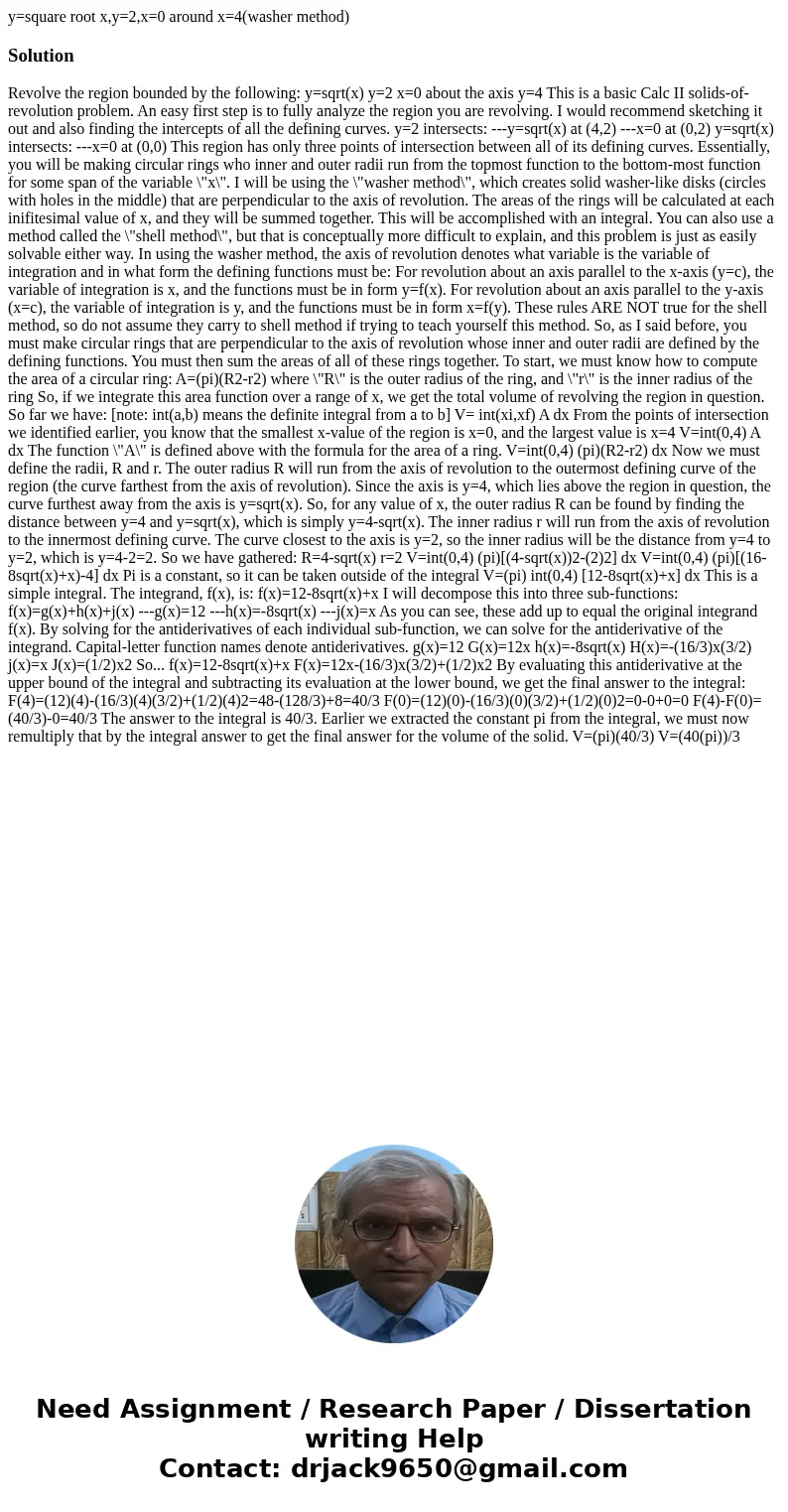ysquare root xy2x0 around x4washer methodSolution Revolve th
y=square root x,y=2,x=0 around x=4(washer method)
Solution
Revolve the region bounded by the following: y=sqrt(x) y=2 x=0 about the axis y=4 This is a basic Calc II solids-of-revolution problem. An easy first step is to fully analyze the region you are revolving. I would recommend sketching it out and also finding the intercepts of all the defining curves. y=2 intersects: ---y=sqrt(x) at (4,2) ---x=0 at (0,2) y=sqrt(x) intersects: ---x=0 at (0,0) This region has only three points of intersection between all of its defining curves. Essentially, you will be making circular rings who inner and outer radii run from the topmost function to the bottom-most function for some span of the variable \"x\". I will be using the \"washer method\", which creates solid washer-like disks (circles with holes in the middle) that are perpendicular to the axis of revolution. The areas of the rings will be calculated at each inifitesimal value of x, and they will be summed together. This will be accomplished with an integral. You can also use a method called the \"shell method\", but that is conceptually more difficult to explain, and this problem is just as easily solvable either way. In using the washer method, the axis of revolution denotes what variable is the variable of integration and in what form the defining functions must be: For revolution about an axis parallel to the x-axis (y=c), the variable of integration is x, and the functions must be in form y=f(x). For revolution about an axis parallel to the y-axis (x=c), the variable of integration is y, and the functions must be in form x=f(y). These rules ARE NOT true for the shell method, so do not assume they carry to shell method if trying to teach yourself this method. So, as I said before, you must make circular rings that are perpendicular to the axis of revolution whose inner and outer radii are defined by the defining functions. You must then sum the areas of all of these rings together. To start, we must know how to compute the area of a circular ring: A=(pi)(R2-r2) where \"R\" is the outer radius of the ring, and \"r\" is the inner radius of the ring So, if we integrate this area function over a range of x, we get the total volume of revolving the region in question. So far we have: [note: int(a,b) means the definite integral from a to b] V= int(xi,xf) A dx From the points of intersection we identified earlier, you know that the smallest x-value of the region is x=0, and the largest value is x=4 V=int(0,4) A dx The function \"A\" is defined above with the formula for the area of a ring. V=int(0,4) (pi)(R2-r2) dx Now we must define the radii, R and r. The outer radius R will run from the axis of revolution to the outermost defining curve of the region (the curve farthest from the axis of revolution). Since the axis is y=4, which lies above the region in question, the curve furthest away from the axis is y=sqrt(x). So, for any value of x, the outer radius R can be found by finding the distance between y=4 and y=sqrt(x), which is simply y=4-sqrt(x). The inner radius r will run from the axis of revolution to the innermost defining curve. The curve closest to the axis is y=2, so the inner radius will be the distance from y=4 to y=2, which is y=4-2=2. So we have gathered: R=4-sqrt(x) r=2 V=int(0,4) (pi)[(4-sqrt(x))2-(2)2] dx V=int(0,4) (pi)[(16-8sqrt(x)+x)-4] dx Pi is a constant, so it can be taken outside of the integral V=(pi) int(0,4) [12-8sqrt(x)+x] dx This is a simple integral. The integrand, f(x), is: f(x)=12-8sqrt(x)+x I will decompose this into three sub-functions: f(x)=g(x)+h(x)+j(x) ---g(x)=12 ---h(x)=-8sqrt(x) ---j(x)=x As you can see, these add up to equal the original integrand f(x). By solving for the antiderivatives of each individual sub-function, we can solve for the antiderivative of the integrand. Capital-letter function names denote antiderivatives. g(x)=12 G(x)=12x h(x)=-8sqrt(x) H(x)=-(16/3)x(3/2) j(x)=x J(x)=(1/2)x2 So... f(x)=12-8sqrt(x)+x F(x)=12x-(16/3)x(3/2)+(1/2)x2 By evaluating this antiderivative at the upper bound of the integral and subtracting its evaluation at the lower bound, we get the final answer to the integral: F(4)=(12)(4)-(16/3)(4)(3/2)+(1/2)(4)2=48-(128/3)+8=40/3 F(0)=(12)(0)-(16/3)(0)(3/2)+(1/2)(0)2=0-0+0=0 F(4)-F(0)=(40/3)-0=40/3 The answer to the integral is 40/3. Earlier we extracted the constant pi from the integral, we must now remultiply that by the integral answer to get the final answer for the volume of the solid. V=(pi)(40/3) V=(40(pi))/3
 Homework Sourse
Homework Sourse